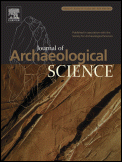Journal of Archaeological Science
 Science Direct
Science DirectThe most recent issue of JAS (October 2007, Volume 34, Issue 10, Pages 1555-1762) is available online. Abstracts are free of charge and full papers are available to purchase as downloads in PDF format.
In this issue there is a paper about ancient Egyptian faience: A technological study of ancient faience from Egypt (Pages 1568-1583) by M.S. Tite, P. Manti and A.J. Shortlandd. The abstract is as follows:
The chemical compositions and microstructures of some 35 faience objects from Egypt spanning the period from the Middle Kingdom through to the 22nd dynasty are determined using analytical scanning electron microscopy. Replicate faience beads glazed in the laboratory using the efflorescence and cementation methods are similarly investigated. In efflorescence glazing, there appears to be preferential efflorescence of soda over potash, and in cementation glazing, preferential take up of potash over soda into the glaze. These data are then used to try to infer the raw materials and methods of glazing employed in the production of the ancient faience. The glaze/glass phases present in the faience differ significantly in composition from that of New Kingdom glass. This could be due either to the use of different plant ashes or to changes in the composition of the plant ashes during the production of faience and/or glass. Although it is only rarely possible to determine with certainty whether ancient faience was glazed by efflorescence, cementation or application, the observed microstructures provide an indication of the approach adopted to achieve desired performance characteristics such as strength.
There is also an article from the previous issue, Volume 34, Issue 9, Pages 1347-1554 (September 2007), which I missed: Migration in the Nile Valley during the New Kingdom period: a preliminary strontium isotope study (pages 1391-1401) by Michele R. Buzon, Antonio Simonetti and Robert A. Creaser:
The value of strontium isotope analysis in identifying immigrants at numerous archaeological sites and regional areas has been demonstrated by several researchers, usually by comparing 87Sr/86Sr values of human tooth enamel and/or
bone with the local strontium isotope signature determined by faunal and environmental samples. This paper examines the feasibility of using 87Sr/86Sr ratios to investigate residential mobility in the Nile Valley region, specifically at the New Kingdom period (1050–1400 BC) archaeological site of Tombos (ancient Nubia). Archaeological and textual information regarding this period indicates that immigrant Egyptians and local native Nubians were likely interacting at this site during a period of Egyptian colonial occupation. The results of this study suggest that non-local individuals may be distinguished from locals using 87Sr/86Sr values and that colonial agents in the Tombos population were probably both local native Nubians and immigrants.
- Making Ancient Egyptian Faience
Egypt at the Manchester Museum (Campbell Price) With photos. Yesterday, I joined a team from the Caer Alyn Archaeological Heritage Project (CAAHP) as they attempted to recreate the ancient Egyptian art of faience production. Faience is a glazed non-clay...
- Informal Book Review - Egyptian Faience And Glass
I brought a number of Shire Publications books away with me. They can be read in a couple of hours (they average about 64 pages long), are written by some excellent authors and stuff a lot of useful information into a digestible package. Most of them...
- Journal Of Archaeological Science Volume 36
JAS Volume 36, Issue 3, Pages 573-936 (March 2009) Available for subscribers or for purchase as in PDF format Identification of a chrysocolla amulet in an Early Dynastic child mummy Journal of Archaeological Science Raffaella Bianuccia, Grazia Mattutinob,...
- New Light On Ancient Egyptian Colonialism
http://www.eurekalert.org/pub_releases/2006-05/uocp-ats051706.php An article in Current Anthropology about the Nubian site Tombos sheds new light on the nature of the relationship between pharaonic Egypt and its Nubian colony: "In approximately 1550 B.C.,...
- Making Faience At Home
Interesting study being done by Dr. Mark Eccleston and his Australian team to see if women and children were making extra income for their families by making faience objects around the stove in the family courtyard. Dr. Eccleston is particularly interested...
